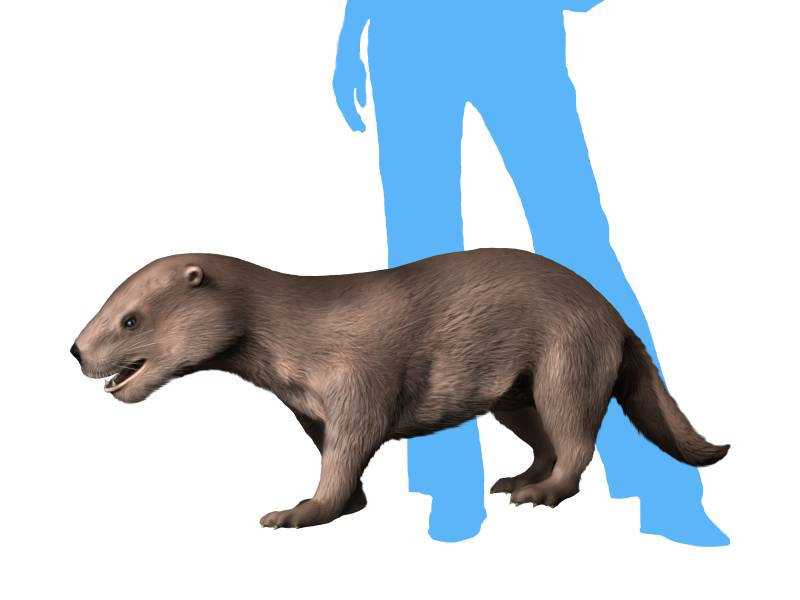Kolponomos Newportensis NT on:
[Wikipedia]
[Google]
[Amazon]
''Kolponomos'' is an extinct genus of carnivoran mammal that existed in the Late Arikareean North American Land Mammal Age, early Miocene epoch, about 20 million years ago. It was likely a marine mammal. The genus was erected in 1960 by
 Based on the skull and jaws known, ''Kolponomos''
Based on the skull and jaws known, ''Kolponomos''
''Kolponomos'' at The Paleobiology Database
{{Taxonbar, from=Q2500116 Miocene mammals of North America Miocene bears Prehistoric marine mammals Prehistoric carnivoran genera Fossil taxa described in 1960
Ruben A. Stirton
Ruben Arthur Stirton (1901-1966), known to his friends as "Stirt", was an American paleontologist, specializing in mammals, who was active in South America, the United States and Australia. Stirton was closely associated with the University of ...
, a paleontologist at the University of California Museum of Paleontology, Berkeley, for the species ''K. clallamensis'', on the basis of a partial skull and jaw found on the Olympic Peninsula. At the time, Stirton questionably assigned it to Procyonidae
Procyonidae is a New World family of the order Carnivora. It comprises the raccoons, ringtails, cacomistles, coatis, kinkajous, olingos, and olinguitos. Procyonids inhabit a wide range of environments and are generally omnivorous.
Character ...
, its systematic position remained problematic until the discovery of more fossils including a nearly complete cranium from the original locality of ''K. clallamensis'' which helped identify it as part of the group from which pinnipeds evolved.
Description
In life, species of ''Kolponomos'' had downturned snouts and broad, heavy molars that would have been suited to a diet of hard-shelled marine invertebrates, and their narrow snouts and anteriorly directed eyes indicate that they would have had stereoscopic vision. Large neck muscle attachments and robust foot bones combine with these features to suggest that ''Kolponomos'' filled a unique niche among marine carnivores, approached today only by the very distantly relatedsea otter
The sea otter (''Enhydra lutris'') is a marine mammal native to the coasts of the northern and eastern North Pacific Ocean. Adult sea otters typically weigh between , making them the heaviest members of the weasel family, but among the small ...
. Due to the lack of a complete skeleton, however, it is difficult to make inferences about this genus' other adaptations.
 Based on the skull and jaws known, ''Kolponomos''
Based on the skull and jaws known, ''Kolponomos'' convergently evolved
Convergent evolution is the independent evolution of similar features in species of different periods or epochs in time. Convergent evolution creates analogous structures that have similar form or function but were not present in the last com ...
mandibular and bite features that had similarities to extant bears, sea otters, and even the sabretooth '' Smilodon.'' The anterior portion of the jaw becomes a functional anchoring fulcrum in both ''Kolponomos'' and ''Smilodon''. Although dental morphology and heavy occlusal wear patterns are shared with the sea otter. ''Kolponomos''Siamogale melilutra
''Siamogale melilutra'' is an extinct species of giant otter from the late Miocene from Yunnan province, China.
Ranking among the largest fossil otters, ''Siamogale'' represents a feeding ecomorphology with no living analog. Its giant size and hi ...
'', although ''Kolponomos'' is not an otter
Discovery
''Kolponomos clallamensis'' is known from the Miocene of Slip Point Lighthouse, Washington (, paleocoordinates ). The species was originally based on a rostrum found in 1957 at Slip Point in Clallam Bay, Washington. A nearly complete cranium was found at the same location in 1988. Both ''K. clallamensis'' and ''K. newportensis'' are associated with the late ArikareeanNALMA
The North American land mammal ages (NALMA) establishes a geologic timescale for North American fauna beginning during the Late Cretaceous and continuing through to the present. These periods are referred to as ages or intervals (or stages when ref ...
.
''Kolponomos newportensis'' was described in 1994 by R. Tedford, L. Barnes and Clayton E. Ray
Clayton may refer to:
People
*Clayton (name)
* Clayton baronets
* The Clayton Brothers, Jeff and John, jazz musicians
*Clayton Brothers, Rob and Christian, painter artists
* Justice Clayton (disambiguation), the judges Clayton
Places Canada
* Cl ...
. It is represented by single specimen: a nearly complete skull, jaw and post-cranial bones found in a concretion of sediment. The concretion was discovered in two pieces by fossil collector Douglas Emlong
Douglas Ralph Emlong (April 17, 1942–June 1980) was an amateur fossil collector from the Oregon Coast in the northwestern United States. His collections contributed to the discovery and description of numerous extinct marine mammal species, man ...
near Newport, Oregon, the first in 1969 and the second, eight years later, in 1977. Because the concretion had been hardened so much by tectonic stress, the paleontological laboratory at the Smithsonian Institution considered them "the most difficult materials ever encountered by our laboratory.," and a combination of techniques proved essential to its extraction and preparation, which lasted two decades. Discovery of ''K. newportensis'' disproved the earlier hypothesis that the genus was related to the ancestors of raccoons, and instead was a stem-pinniped.
References
External links
''Kolponomos'' at The Paleobiology Database
{{Taxonbar, from=Q2500116 Miocene mammals of North America Miocene bears Prehistoric marine mammals Prehistoric carnivoran genera Fossil taxa described in 1960